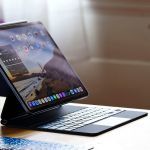Dominique Luchart's Blog, page 646
April 21, 2021
Apple’s $64 billion-a-year App Store isn’t catching the most egregious scams,

 Illustration by William Joel / The Verge
Illustration by William Joel / The VergeRecently, I reached out to the most profitable company in the world to ask a series of basic questions. I wanted to understand: how is a single man making the entire Apple App Store review team look silly? Particularly now that Apple’s in the fight of its life, both in the courts and in Congress later today, to prove its App Store is a well-run system that keeps users safe instead of a monopoly that needs to be broken up.
That man’s name is Kosta Eleftheriou, and over the past few months, he’s made a convincing case that Apple is either uninterested or incompetent at stopping multimillion-dollar scams in its own App Store. He’s repeatedly found scam apps that prey on ordinary iPhone and iPad owners by luring them into a “free trial” of an app with seemingly thousands of fake 5-star reviews, only to charge them outrageous sums of money for a recurring subscription that many don’t understand how to cancel. “It’s a situation that most communities are blind to because of how Apple is essentially brainwashing people into believing the App Store is a trusted place,” he tells The Verge.
There’s a lot to unpack there: fake free trials, fake reviews, subscription awareness. We could write an entire story about each. Today, I’d like to focus on how one guy could find what Apple’s $64-billion-a-year App Store apparently cannot, because the answer is remarkable.
You simply look at the apps that are making the most money. Then, you find ones where the user reviews are suspicious and look for ridiculously high subscription prices.
That’s it. There’s no step four. Eleftheriou tells us this is how he started finding these scams, but you don’t need to be a coder to figure it out.
Heck, let’s try it together right now.
While Apple doesn’t share “top grossing” charts for the App Store any more (that seems to have died with the introduction of iOS 11 in 2017), companies like SensorTower still publicly share that data. All you have to do is pick an app category — say, Business — and click through the results.
Here’s “Call Recorder iCall,” the #26 top-grossing app in the Business category on the day I checked. As you can see below, “Charlier Brown” says he’s 100 percent satisfied and there’s a 3-day free trial, so what do we have to lose other than… $9.99 a week? Hooo boy.
 “Charlier Brown” thinks you’ll like this call recorder appScreenshot by Sean Hollister / The Verge
“Charlier Brown” thinks you’ll like this call recorder appScreenshot by Sean Hollister / The VergeUsers of the app tend to complain they can’t figure out how to cancel that $520 a year subscription — and that the app often stops recording after just a handful of seconds. Yet somehow it’s got a 4.5-star rating on the App Store. And fake reviews clearly have something to do with it. Here are a few :
No real downside by Leena Hayes
The app is free and is very versatile. Obviously if you are more into working out it may not be the best (there are high lv’s so it can be difficult) but for what it offers you it’s fantastic
Best at home at I’ve found by Darren Gorham
Ive tried various at home apps to use in between the gym and none of them are as easy to use. The workouts are effective and I love the tracking it provides along with caloric counts and timing
No equipment needed by Rosalba Noble
If you want to feel better about yourself & not join a gym, highly recommend this app as it gets you motivated to bigger as in more reps – not weights. I think its great to use your own body weight to get that burning workout
Call Recorder iCall is clearly not an exercise app, but that doesn’t seem to have stopped these “reviewers” from trying.
Now, let’s try the #8 top-grossing app in the Utilities category: “Roku Remote Control – Roki,” which seems a little suspicious when you consider that Roku gives away its own official remote control app for free. Here are a few choice one-star reviews:
Taking my money by 804user
I paid for the $19.99, but I am still being charged each month and still have yet to hear back from any type of customer SERVICE….BEWARE!!!
Didn’t work by lawstudent1989
And now I can’t cancel my subscription in the app it and I’m worried it’s just a farce to get my credit card info.
Not impressed by FallenWish
So originally I had this app on my android and it was free but now we have to pay for it?Like we don’t already dole out 300 dollars or more for the tvs ??There is just no winning
And here’s the first screen you’ll see after downloading:
 This Roku remote looks like such a good deal.Screenshot by Sean Hollister / The Verge
This Roku remote looks like such a good deal.Screenshot by Sean Hollister / The VergeHow could an app like this possibly have a 4.5-star rating in the App Store? Well, it wouldn’t if you actually averaged out each written review: Apple’s “4.5” counts every disembodied rating where someone punched in a number of stars, even if that was just to dismiss an annoying pop-up so they could try the app. As Eleftheriou tells me (pointing to his tweet, which I’ve embedded below), Roki would have had a rating of just 1.7 stars if you only counted reviews.
Out of 15,000 ratings, only 338 reviews! And their average?
1.7 stars
ONE. POINT. SEVEN.
— Kosta Eleftheriou (@keleftheriou)
Here’s the kicker: Eleftheriou called out this app’s behavior two months ago, and yet it still exists in the App Store today. It’s not clear why, but it brings me to another important point. Even when people point out these shady apps, Apple doesn’t necessarily take action — and as Eleftheriou pointed out to me during our conversation, The Verge has some direct experience there.
On February 8th, we brought a bunch of these scams to Apple’s attention with this story, which prominently embedded a tweet by Eleftheriou about another scammy app called “Star Gazer+“.
4.6 stars, with over 80,000 ratings, and a glowing 5-star “featured” review: pic.twitter.com/Aup1ehYTdk
— Kosta Eleftheriou (@keleftheriou)
Apple didn’t remove that app for two whole months, and won’t tell us the reasons for the delay. On the record, Apple would only provide this statement for our story:
“We designed and built the App Store to be a safe and trusted place for our users, and are constantly improving our processes to reduce fraud, malware and spam. To provide our users with the best experience, we regularly reject and remove apps, as well as fraudulent ratings and reviews, resulting in millions of removals every year. We intend to keep at this important work to ensure users can confidently download the apps they love and developers continue to make the App Store a great business opportunity.”
Star Gazer+ finally disappeared on April 8th, after Apple was approached by another journalist who publicly asked why it was taking so long. (It also happened to be the day Epic Games drew attention to some of these scams in a legal filing, though we’re not sure either is the true reason.) And while it appears that its publisher Dragon Game Studio has been booted off the App Store in the process, Apple appears to have overlooked its other publisher account for co-founder Jonas Johnsson, whose current claim to fame — no joke — is a “Ghost Detector+” with a $5/week recurring subscription fee.
Johnsson’s also got an $8/week horoscope app, and I’m sorry, this juxtaposition of angry reviews and a 4.5 score makes me laugh:
 Seems like a bit of a mismatch here, Apple?Screenshot by Sean Hollister / The Verge
Seems like a bit of a mismatch here, Apple?Screenshot by Sean Hollister / The VergeWhile it’s impossible for us to tell how many of the horoscope app’s 32,000 star-only ratings are fake, Eleftheriou says Apple should have no problem with that. “When you consider refund request rates, app usage, and other associated info that only Apple has, you could imagine a totally revamped discovery system that does away with the current crude star-rating system that hasn’t seen any innovation since Bezos pioneered it 20 years ago,” he suggests.
During my hunt for scam apps, I also notice that some reviewers of these shady apps complain that developers are asking them for money a second time, even though they already purchased full premium access, and Eleftheriou says it sadly appears to be a theme: “A lot of scammers go and buy successful apps from people, and all they need to do is take that skeleton, make minor modifications and make a lot of money,” he says.
To get a sense of just how much money these scams are bilking out of people, here are some comparisons Eleftheriou made when he spotted a VPN app scam last week, one that Apple was remarkably quick to shut down (after myself and a number of other journalists reached out to Apple about the painfully obvious scam):
To give you an idea, that’s more recurring revenue than apps like:
– Microsoft Word
— Kosta Eleftheriou (@keleftheriou)
– Microsoft OneDrive
– Google Drive
– Washington Post
– Fox News
– Bloomberg
– NBC Sports
– Grand Theft Auto
– NBA LIVE
– Monopoly
– DocuSign
– Udemy
– LastPass
– GoPro
But it’s only “quick” if you ignore that Apple didn’t stop the scammers for six whole months, even though they caught the exact same developer doing the exact same thing months before:
It gets worse. This developer is a repeat offender inside Apple’s “walled garden”.
They had *another* VPN scam that netted them over half a MILLION dollars before it was shutdown early 2020.
But now knowing Apple’s lack of punishment they’re even more brazen & more profitable. pic.twitter.com/R99l9Rn21u
— Kosta Eleftheriou (@keleftheriou)
You would think Apple would keep these off the App Store, right? And if not then it would at least root them out, catch the scam artists, and keep them from doing it again. Yet that doesn’t seem to be happening. While Apple currently makes an estimated $64 billion a year from its App Store and tells The Verge it has computer automation, proprietary review tools, huge volumes of internal data, and a dedicated “Discovery Fraud team” of humans at its disposal, a single person on a laptop in his living room is finding egregious scams that Apple continues to host, and I was able to use his basic technique to do the same thing. As Apple faces down hearings in Congress and lawsuits in court, its argument that it needs to maintain total control over the iPhone app ecosystem to keep users safe doesn’t mesh with the obvious examples of grift that anyone can easily find.
Here’s another scam Eleftheriou spotted (I highly recommend this whole thread):
You think the @AppStore is “a place you can trust”?
Think again!
How to spot a $5M/year scam, in 5 minutes flat:
— Kosta Eleftheriou (@keleftheriou)
And another:
I don’t know what’s worse about this app:
– “Translated” fake reviews
– “Recommended by Apple” popups in Safari
– https://t.co/Kq5lRrKCWc contact email
– Blank website, registered in India
– $9.99/week subscription
– Grossing $1M (!) a monthWhat is Apple even doing?? pic.twitter.com/5oUBCJ2GNh
— Kosta Eleftheriou (@keleftheriou)
And another. (If you find some, too, Eleftheriou would love to hear from you at bunco.squad@hey.com.)
So once again, Apple took down another app I exposed but is cool with the developer running their other, even *more* profitable scam. I’m speechless.
Below you see “Live Wallpaper Z”, allowed to keep stealing $40k/month from unsuspecting people.
How do I know? pic.twitter.com/KkehMixic8
— Kosta Eleftheriou (@keleftheriou)
Eleftheriou tells me that Apple has removed over 100 apps due to his reports — and if you’re wondering whether his online crusade is personal, the answer is most definitely yes. He began digging for scams after his own app FlickType, a keyboard for Apple Watch, was overtaken by scam apps that didn’t work and charged ludicrous fees, yet prospered due to fake reviews. What’s more, he claims Apple gave his competitors (and scammers) a leg up by refusing to initially approve his app — because Apple was hoping to acquire it from him at a cheap price instead. Last month, he filed a lawsuit against Apple for two years of lost revenue and other damages. So he’s absolutely got skin in the game.
But I don’t think that lessens the impact of his Twitter threads about where, precisely, Apple’s App Store is falling down on the job. The fake review situation seems bad. So do the difficult-to-cancel recurring subscriptions. While I like to think most Verge readers will see the fine print and know how to cancel, and Apple’s been getting better about mandated warnings, the bewildered reviews on these apps are a sign that many iPhone and iPad users are still having trouble.
Eleftheriou suggests to me that the kind of users who might be most vulnerable to these scams are experiencing a kind of perfect storm: “They get virus pop-ups in Safari, they’re directed to the App Store and think the app is recommended by Apple, they download the app thinking it’ll help them, it’s got the perfect ratings, and they’re not savvy enough to know.”
He shares a chart with me (from AppFigures, see below) about how long it can take for vulnerable users to turn off recurring subscriptions: “Only half will have figured out how to cancel it two months later. The other half still hasn’t figured it out after 8 whole weekly billing cycles,” he says.
 “Only half will have figured out how to cancel it two months later.”Chart by AppFigures
“Only half will have figured out how to cancel it two months later.”Chart by AppFiguresSituations like these make it harder than ever for Apple to justify its constant rhetoric about how the App Store is safe, secure, and defended, or that it’s necessary for Apple to be solely in charge, something that has already been in question for years due to the company’s arbitrary enforcement of its rules and recent App Store cash grabs.
And we’re starting to hear from Apple insiders, too, that the company’s claims about App Store security are overblown. Eric Friedman, the head of the company’s Fraud Engineering Algorithms and Risk (FEAR) team, will be testifying in next month’s Epic Games trial. In a recent deposition he spoke of the App Review team as “bringing a plastic butter knife to a gun fight” and “more like the pretty lady who greets you with a lei at the Hawaiian airport than the drug sniffing dog.” His team reportedly believed App Review’s job was incentivized to get apps “through the pipe” and “move people through” like TSA employees. “App Reviewers typically review between 50 to 100 apps per day,” reads part of Epic Games’ filing.
Other App Store executives deposed for the Epic Games trial admitted that they were aware of a number of the types of scams we’re discussing today, including ringtone apps that reportedly raked in hundreds of thousands of dollars a month despite users warning against them — start at page 170 here (PDF) for examples.
“Apple likes to tie the App Store together with the system level protections, and bundle them together as the reason why the distribution is secure, but really it’s the system-level protections that are doing all the work,” says Eleftheriou.
Meanwhile, Apple former senior director of worldwide marketing (and noted tech analyst) Michael Gartenberg praised Eleftheriou’s recent efforts to highlight scams, suggesting that the Apple ecosystem is “breaking at the seams.”
I believe @keleftheriou has brought an important issue about the App Store to a mainstream audience. I hope Apple gets its act together soon. The ecosystem that is often praised is breaking at the seams IMHO
— Michael Gartenberg (@Gartenberg)
But the thing I’m stuck on is how the most profitable company in the world, a company that has long justified a 30-percent cut of the App Store’s billions because of its App Review efforts, a company with multiple enforcement teams and access to internal data, isn’t doing the simple task of auditing the App Store’s top-grossing apps for fraud.
It’s not a novel idea: Daring Fireball‘s John Gruber suggested it in December 2018, and again in 2019, and again in 2020.
They don’t have to look through them all. Even if that were possible it’d be stupid. All they have to do is police the most popular ones. If they simply looked at the top charts and scanned for scams they’d find most of them.
— John Gruber (@gruber)
But though Apple claims “the apps we offer are held to the highest standards for privacy, security, and content,” and that “moderators review worldwide App Store charts for quality and accuracy” every single day, it doesn’t seem to have taken this simple step.
Apple would not tell me why one man is continuing to find egregious apps that Apple’s fraud and app review teams are missing, or whether it goes back to inspect the App Store’s most lucrative apps for fraud. The company would not say how it protects customers against fake reviews, or whether any customers that fell for these scams will get refunds, or how it plans to combat scams in the future.
Apple did say generically that it does offer the ability to request refunds; that it does re-review apps against its App Store guidelines; and that it has improved its subscription processes both by 1) requiring app developers to clearly display what customers are getting into and how to cancel, and 2) prompting users to “manage” their subscription at the time they delete an app.
I repeat my request from last year: the App Store needs a bunco squad — a team that hunts for and is empowered to take action against scammy apps. And ban repeat offenders. https://t.co/nGpZeALUdw
— John Gruber (@gruber)
By the way: you know that app that John Gruber helped draw attention to in 2019, the one that reportedly charged $10 every week for wallpaper you could find free online? It’s still on the App Store. Never got removed.
It currently has a 4.1 rating, despite countless negative reviews, and SensorTower estimates the app still makes its developer $10,000 a month.
The post Apple’s $64 billion-a-year App Store isn’t catching the most egregious scams, appeared first on NEWDAWN Blog.
Apple’s $64 billion-a-year App Store isn’t catching the most egregious scams, Sean Hollister

 Illustration by William Joel / The Verge
Illustration by William Joel / The VergeA one-man Bunco Squad is poking holes in Apple’s App Store image
The post Apple’s $64 billion-a-year App Store isn’t catching the most egregious scams, Sean Hollister appeared first on NEWDAWN Blog.
Gogoro is bringing its electric scooter and battery tech to India, Sean O’Kane

 Images: Gogoro
Images: GogoroGogoro is branching out of home country Taiwan in the biggest way yet, as it just announced a partnership with major two-wheeler manufacturer Hero MotorCorp to bring its swappable battery and scooter tech to India. As part of the deal, Hero will build electric scooters based around Gogoro’s tech, and will also install Gogoro’s battery-swapping stations in cities throughout the country.
Electric vehicles could help eat away at some of India’s pollution, and Tesla is even wading into the market. But building out charging infrastructure to handle passenger EVs is going to be a challenge for any company that wants to build a business there.
It’s a different story for scooters, and especially the ones made by Gogoro, which was founded by a…
The post Gogoro is bringing its electric scooter and battery tech to India, Sean O’Kane appeared first on NEWDAWN Blog.
HTC downplays leaked Vive Air headset, says it’s just a concept,

HTC has downplayed leaked images that appeared to show a new fitness-focused VR headset built by the firm. Pictures and details of the HTC Vive Air leaked online earlier this week on a design award website but HTC now says the headset is “only a concept.”
“It’s exciting to see our concept piece, the VIVE Air VR headset, win an iF Design Award,” the company said in a statement given to UploadVR. “While this is only a concept, the design language has elements and inspirations you’ll see elsewhere in our products. We’re not ones to rest on our laurels, so although it’s great to win this award, we have business to attend to — hopefully we’ll see you on 11/12 May at ViveCon.”
 The HTC Vive Air claimed to be made from breathable knitted fabrics.
The HTC Vive Air claimed to be made from breathable knitted fabrics. This statement doesn’t completely rule out that some similar product is in the works from HTC, but the company is definitely keeping things carefully ambiguous. It has been teasing a new headset reveal at ViveCon next month, but the images and hints we’ve seen so far suggest an enterprise-focused model rather than a fitness device for general consumers.
That’s a shame, as VR fitness is having something of a moment, and the idea of a specially-designed, lightweight and washable headset is an appealing idea. With HTC’s consumer business in the doldrums, though, it’s perhaps not a sensible target for the company right now. We’ll just have to wait and see what the firm has in store at ViveCon in May.
The post HTC downplays leaked Vive Air headset, says it’s just a concept, appeared first on NEWDAWN Blog.
HTC downplays leaked Vive Air headset, says it’s just a concept, James Vincent

 Leaked images appeared to show a new fitness-focused VR headset from HTC.
Leaked images appeared to show a new fitness-focused VR headset from HTC. HTC has downplayed leaked images that appeared to show a new fitness-focused VR headset built by the firm. Pictures and details of the HTC Vive Air leaked online earlier this week on a design award website but HTC now says the headset is “only a concept.”
“It’s exciting to see our concept piece, the VIVE Air VR headset, win an iF Design Award,” the company said in a statement given to UploadVR. “While this is only a concept, the design language has elements and inspirations you’ll see elsewhere in our products. We’re not ones to rest on our laurels, so although it’s great to win this award, we have business to attend to — hopefully we’ll see you on 11/12 May at ViveCon.”
The HTC Vive Air claimed to be made from…The post HTC downplays leaked Vive Air headset, says it’s just a concept, James Vincent appeared first on NEWDAWN Blog.
April 20, 2021
Luigi is joining Lego’s interactive Mario sets,

Luigi — everyone’s favorite also-ran brother of the most famous mushroom-stomping plumber — is joining Lego’s interactive Super Mario collection of sets in a new starter kit (creatively titled the LEGO Super Mario Adventures with Luigi Starter Course.)
The new Luigi figure is technologically similar to the Mario one, with a built-in display that animates his eyes, mouth, and a main screen on his chest and a sensor on the bottom that’s used to scan barcodes and brick colors. The main differences are cosmetic here — Luigi looks different, and features different sound effects, voice lines, and character interactions.
[embedded content]In addition to Lego Luigi, the new starter course also includes a Pink Yoshi, a Bone Goomba, and Boom Boom for players to defeat — or add to their larger Lego Super Mario creations. The new Luigi character is also compatible with all the previous sets, should players want to explore their old courses from a fresh perspective.
The Luigi Starter course is set to launch on August 1st for $59.99, the same price as the Mario Starter course set. Preorders are available now from the Lego website.
The post Luigi is joining Lego’s interactive Mario sets, appeared first on NEWDAWN Blog.
Amazon is opening a hair salon in London to trial new technology,

Amazon’s latest bricks-and-mortar experiment is, unexpectedly, a hair salon. The company is opening its Amazon Salon in London’s East End Spitalfields area, where it says it will trial “the latest industry technology.” This includes an augmented reality app that lets customers see what different hair styles and colors look like on them before they decide on a change.
Unlike the company’s cashierless Go grocery stores (which expanded to London last month), Amazon Salon does not seem to be a beachhead for an industry invasion. “This will be an experiential venue where we showcase new products and technology, and there are no current plans to open any other Amazon Salon locations,” said the company in a blog post.
Instead, it looks more like a modest marketing stunt meant to signal the company’s ambitions in the fashion and beauty sectors generally. These have been sectors where Amazon has struggled to make in-roads against specialist stores. The arrival of the Amazon Salon in London follows the company’s launch of its Amazon Professional Beauty Store in the UK, an online storefront that sells wholesale spa and salon products to businesses.
Amazon Salon will occupy more than 1,500 square feet of space across two floors at a location in Brushfield Street. As well as playing around with AR haircut apps (and getting an actual haircut), visitors will be able to test new “point-and-learn” technology” which allows them to “simply point at the product they are interested in on a display shelf” to bring up more information and purchasing options on a nearby display. That includes QR codes to buy specific items. It sounds pretty underwhelming.
Anyone wanting to get an Amazon-brand trim will have to wait, though. The Amazon Salon will initially only be open to Amazon employees with the hoi polloi allowed entry some time “in the coming weeks.” When you go, be sure to ask for the Jeff Bezos “slaphead special.” We hear it’s very efficient.
The post Amazon is opening a hair salon in London to trial new technology, appeared first on NEWDAWN Blog.
Sony launches ‘Silent White’ WH-1000XM4 headphones because the black void of space is too loud,

Picture the scene. It’s summer, lockdowns are easing, and you’re ready to venture back out into the world. You’re feeling brave after a year stuck inside, brave enough that you’ve picked out an all-white outfit. You read up on how to make the color work in the likes of Vogue and GQ, but suddenly, disaster strikes. You notice something. “The Verge’s top rated wireless headphones!” you exclaim to no-one in particular, “they’re only available in black, blue, or this weird dork-ass beige?!”
It’s ok, don’t fret. Sony is releasing a limited edition of the WH-1000XM4 headphones in all white. Better still, it’s real white, not that orthopedic brown Sony’s being trying to pass off as “silver” all these years. Sony promises these “Silent White” headphones will be “even more stain-resistant,” which will hopefully help keep them looking pristine for at least a little while. Unfortunately they’re limited edition, and will only be available while stock lasts.

Internally these are the same as the excellent WH-1000XM4 headphones the company released last year. That means you’re getting excellent audio quality, noise cancellation, and mic performance, and the ability to pair with two devices simultaneously.
The white headphones will be available in Europe from May for EUR430/GBP400, but there’s no sign of the color on Sony’s US site as of this writing. We’ve contacted the company to ask about US availability.
The post Sony launches ‘Silent White’ WH-1000XM4 headphones because the black void of space is too loud, appeared first on NEWDAWN Blog.
Now the iPad Pro has to live up to the MacBook Air,

Today, we’re expecting a grab bag of new products from Apple, headlined by new iPad Pros. Given the relatively minor spec bumps that we got on last year’s iPad Pros, this time around we’re hoping for a more substantial update. In some ways, it seems likely that Apple will deliver, at least with the larger 12.9-inch iPad Pro.
I’m sure the specs will be impressive. But after the release of the first MacBooks with Apple’s own M1 ARM-based silicon, there’s a strange inversion happening. Before, we’d look at a MacBook and wonder why it can’t have the power and battery life of an iPad. Now, I think more and more people are going to join me in looking at the iPad and wondering why it can’t have the flexibility and power of a Mac.
In short, Apple’s silicon didn’t just catch the Mac up to the iPad, it catapulted the Mac beyond the iPad. The M1 MacBook Air is fast, responsive, has no fan, runs any Mac app I throw at it (including Intel apps) very quickly, and even can run some iPad apps (though that experiment isn’t going super well). It is easily the best general-purpose laptop I’ve used in half a decade.
That big of a leap can’t help but recast the iPad’s development over the years. As just one data point, I’ve used both iPad Pros and M1-based MacBooks as my daily work computer and the MacBook Air has better battery life. An iPad can last for days and days if you just use it for tablet tasks, but log in to all your stuff and run it all day like you do your laptop and it’ll conk out a few hours short of the MacBook Air.
From one perspective, I get that it’s silly to just one-to-one compare the iPad and Mac. The iPad is more flexible in its hardware: you can sit on the couch with it, you can use a stylus with it, attach a keyboard, and — get this — touch the screen. When I speak to Apple executives, they express little of the Mac vs iPad angst I see online (and feel myself). Nobody’s actually confused between these two devices, they argue, and I believe it. One of my core beliefs about consumer technology is that consumers are savvier and smarter than they usually get credit for.
That savvy cuts both ways, though. Because from the other perspective, everybody is capable of just looking at each computer’s capabilities and seeing that the Mac can just do more. It’s not quite true that the iPad’s functionality is merely a subset of the Mac’s, but in the Venn diagram of the two the iPad-only part of the circle isn’t very big.
Another way of looking at it is this: it used to be that you would go for the iPad because the MacBook was just fundamentally worse at a few things like speed and battery life. Now that we have MacBooks with Apple Silicon, that list is significantly shorter.
Can the iPad Pro jump back ahead through purely hardware specs? It’d be tough. According to Mark Gurman at Bloomberg, the iPad Pro is supposed to get an “updated processor that is on par with the faster M1 chip in the latest MacBook Air.” There are significant differences between how Apple puts together iOS chips and MacBook chips, but let’s just assume it’s easy to compare and the iPad gets faster. So what? Apple has the enviable problem right now of having computers that are more than fast enough for the vast majority of people. I don’t know anybody who’s actually complaining about the iPad Pro’s speed or graphical capabilities.
New cameras? Sure. LIDAR? I remain unconvinced it’s a must-have feature for anybody. The one thing that might matter is the rumored fancy, new Mini LED screen technology on the larger iPad Pro. That will make it look more like a high-end TV, with brighter brights and blacker-blacks. One of the best things to do on an iPad is watch video, and so it might convince some people to upgrade just for the screen.
In my review of the M1 MacBook Air, I called it a “triumph” and was seriously considering giving it a perfect score until I saw how dumpy the webcam still is. That’s one place where the iPad has a much better spec: the iPad Pro’s front facing camera is excellent. It’s also in the wrong place, on the side when you use it horizontally instead of on the top. That’s the iPad Pro in a microcosm: stupefyingly good hardware with some stupid limitations in how Apple expects it to be used.
The story with the iPad — and especially the iPad Pro — since before Apple’s 2018 “What’s a computer” TV ad has been the same. Can its iOS-based software be opened up and extended enough to allow both developers and users to get it to do the things they want. Apple made a huge step in that direction with iPadOS in 2019, but there’s still a long way to go.
Today’s iPad Pros are likely to be amazing feats of technology, but the really important iPad announcement will come this summer at WWDC, when Apple will unveil its plans for iPadOS. Right now I use the iPad Pro every day, but mostly as a Sidecar display for my MacBook. It’s just much more useful as a Mac screen than it is as an iPad screen.
The post Now the iPad Pro has to live up to the MacBook Air, appeared first on NEWDAWN Blog.
Amazon’s 1st Kuiper megaconstellation satellites will launch on a ULA Atlas V rocket, ,

Amazon has selected United Launch Alliance (ULA) to start launching its megaconstellation of internet satellites to space.
ULA will participate in nine launches of Project Kuiper, which Amazon hopes will eventually send 3,236 advanced satellites to low Earth orbit. The number of satellites ULA will send aloft was not disclosed in a press release from the two organizations, nor was the value of the launch contract.
The missions will proceed on ULA’s Atlas V rocket from Space Launch Complex 41 at Cape Canaveral Space Force Station in Florida at some date, also yet to be announced. Atlas V is a veteran of numerous Earth and Mars missions to low Earth orbit and beyond, including Global Positioning System satellites, the New Horizons mission to Pluto, the recently landed Mars Perseverance rover, as well as the Curiosity rover and Insight missions that landed on Mars in 2012 and 2018.
In photos: Atlas V launches AEHF-6 military satellite for US Space Force
“We could not be more pleased to be working with Amazon to support the initiative,” Tory Bruno, ULA’s president and CEO, said in a statement.
Amazon hinted that it will be looking at other companies to launch satellites into space on its overall aim to provide broadband Internet for underserved communities in remote or rural areas. The satellites and dispensing system are designed “to accommodate multiple launch vehicles — this gives us the flexibility to use many different rockets and providers to launch our satellite system,” Rajeev Badyal, vice president of technology for Project Kuiper, said in the same statement. “Atlas V is a capable, reliable rocket, and we’re proud to be working with ULA to support these important first launches,” Badyal added.
Amazon has been quiet about revealing details about Project Kuiper, which it first announced in 2019. At the time of the announcement, the company did not disclose details such as which companies would be building the satellites, nor when it plans to have the constellation in orbit.
Its initial plans filed with the International Telecommunication Union included 784 satellites in a 366-mile (590 kilometers) orbit, plus 1,156 satellites in a 391-mile (630 km) orbit and 1,296 in a 380-mile (610 km) orbit, which firmly places the satellites in low Earth orbit. For comparison, the International Space Station’s average orbit is 250 miles (400 km).
[image error]
An artist’s rendering of a United Launch Alliance Atlas V rocket launching Amazon’s Kuiper satellites from Space Launch Complex 41 at Cape Canaveral Space Force Station in Florida. (Image credit: Amazon)In July 2020, Kuiper received unanimous approval from the Federal Communications Commission (FCC), which regulates telecommunications services in the United States, to deploy the satellite constellation.
Amazon will enter a growing competitive market for broadband satellite business, including SpaceX’s Starlink (already in force with more than 1,400 satellites), Boeing, the European company Thales Alenia and Telesat Canada.
Critics worry about the effects of these various satellite groups on professional astronomy observations, particularly wide-field sky surveys.
Amazon said it plans to spend more than $10 billion on the constellation. Services will include ground-station service for customers ranging from households to large businesses. It will also provide backhaul (the side of the network that communicates with the Internet) for ongoing 5G deployment worldwide; 5G is a faster mobile protocol that supports the Internet of Things, among other benefits.
Follow Elizabeth Howell on Twitter @howellspace. Follow us on Twitter @Spacedotcom and on Facebook.
The post Amazon’s 1st Kuiper megaconstellation satellites will launch on a ULA Atlas V rocket, , appeared first on NEWDAWN Blog.



